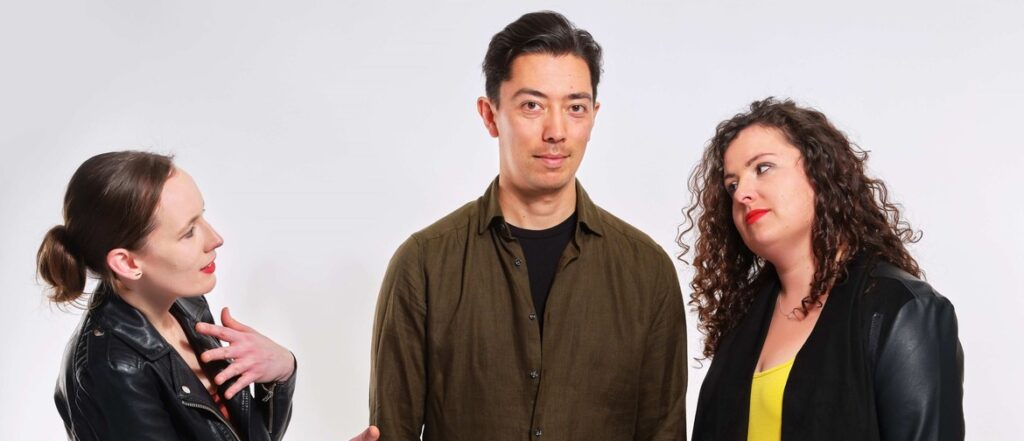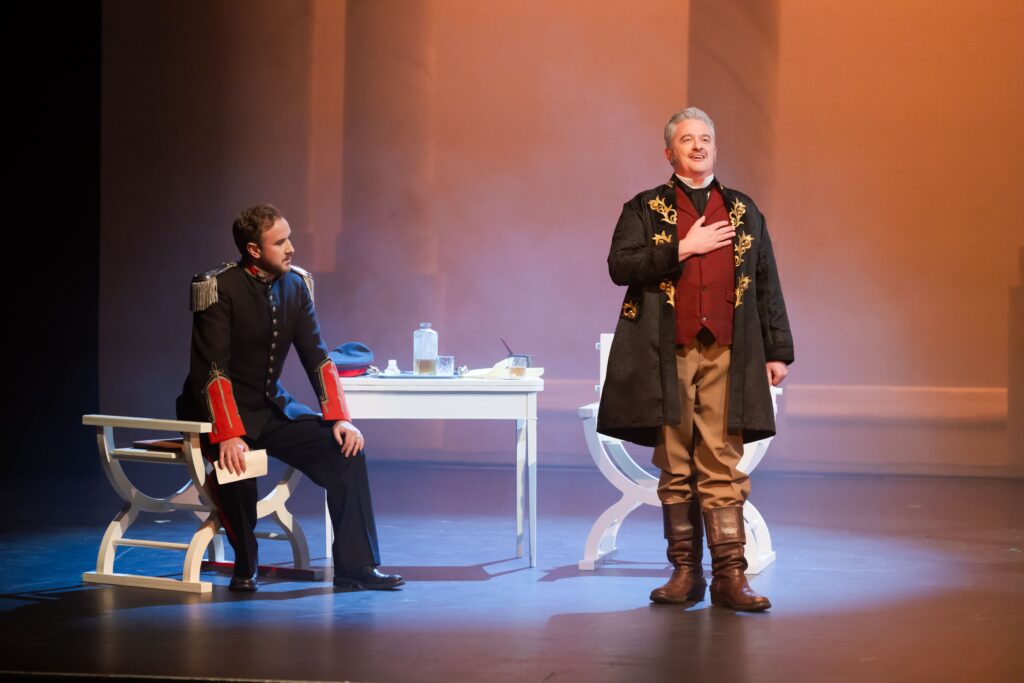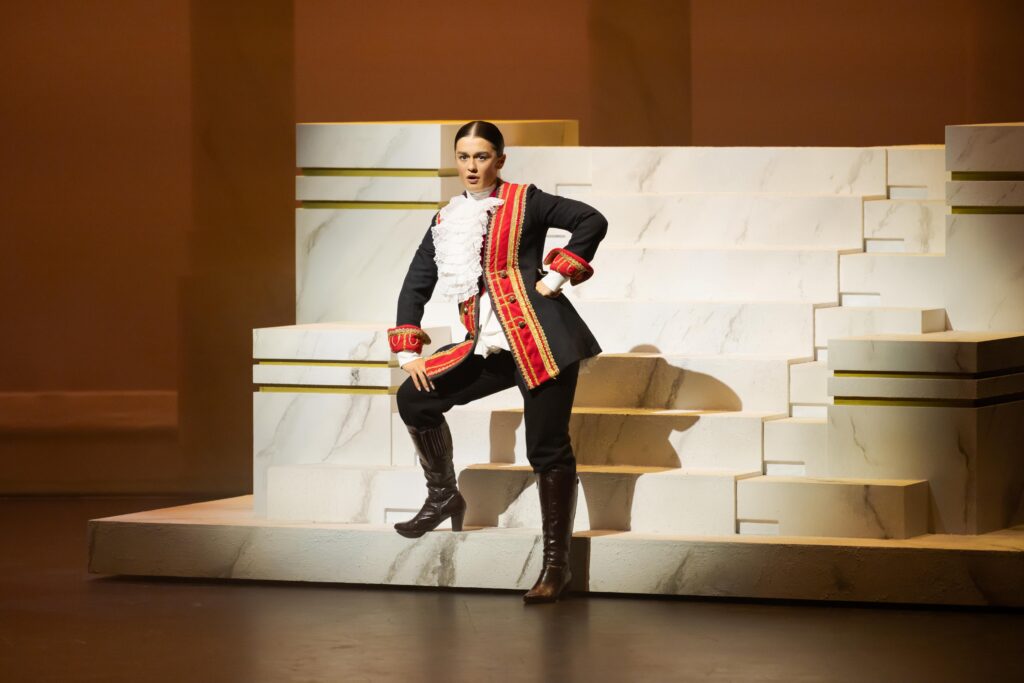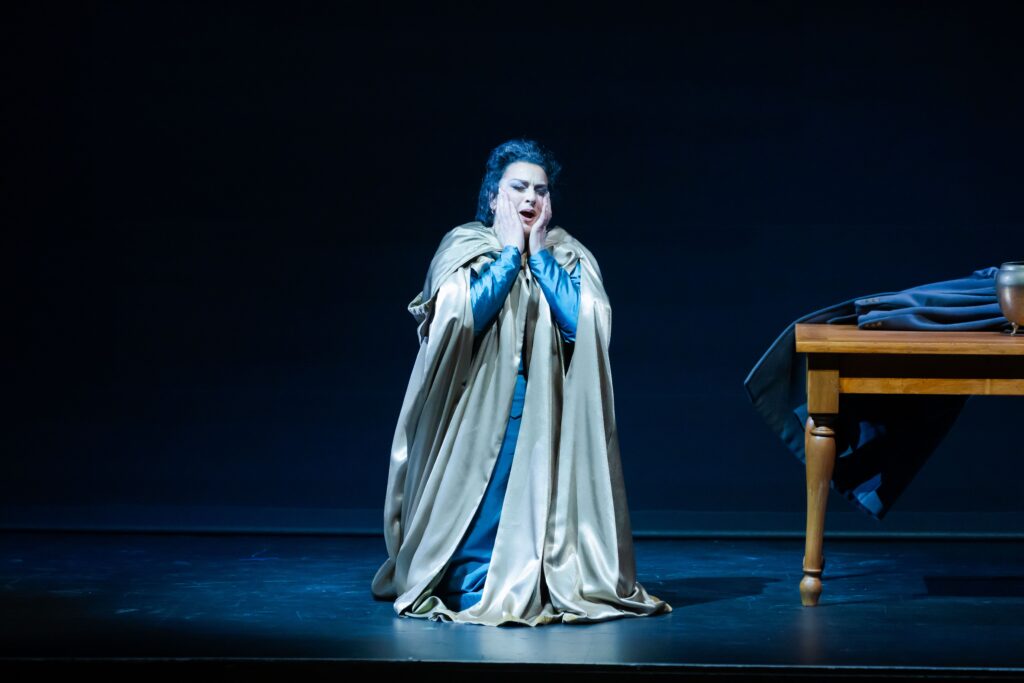
STROMA – Heaven and Earth – a celebration of 25 years of bold new music
Works by Leila Adu-Gilmore, Olivier Messiaen, Gemma Peacocke, John Rimmer,
Sofia Gubaidulina and Michael Norris
OLIVIER MESSIAEN – Louange à l’immortalite de Jesus (1941)
Vesa-Matti Leppänen (violin), Gabriela Glapska (piano)
LEILA ADU-GILMORE – Heaven is Life (2025) (premiere)
Julia Broom (violin), Nicholas Hancox (viola). Ken Ichinose (‘cello)
JOHN RIMMER – When Sea Meets Sky 2 (1975)
Hamish McKeich (conductor), Bridget Douglas (flute), Patrick Hayes
(clarinet), Lenny Sakofsky (percussion), Gabriela Glapska (piano),
Julia Broom (violin), Ken Ichinose (‘cello)
MICHAEL NORRIS – The Spaces in Between (2025)
Gabriela Glapska (piano), Anna van der Zee (violin) Ken Ichinose (cello)
SOFIA GUBAIDULINA – Garten von Freuden und Traurigkeit (1980) (Garden of Joy and
Sorrow)
Bridget Douglas (flute) / Michelle Velvin (harp) Nicholas Hancox ( viola)
GEMMA PEACOCKE – Sky-fields (2020)
Bridget Douglas (flute), Gabriela Glapska (piano) Ken Ichinose (cello)
Thomas Guldborg (percussion)
Public Trust Hall, Wellington,
Wednesday, 27th August, 2025
This was a red-letter concert for Wellington’s contemporary music ensemble Stroma, being the 25th anniversary (almost to the day) of the ensemble’s very first concert on the 18th of August, 2000. Michael Norris, one of the founders of the fledgling group (and a co-director of the present Stroma Ensemble) welcomed us all warmly, outlining for us something of the flavour of the group’s genesis and current raison d’etre, including the evening’s inclusion of both home-grown and off-shore works, and the presence of at least one premiere (see below).
The concert this evening actually began with an excerpt from a larger work by Olivier Messiaen – which I’ll describe at the end of this review, and instead give pride of place to the palpable excitement generated by the evening’s premiere, second on the programme. This was New Zealand composer Leila Adu-Gilmore’s Heaven is Life, a work which has its genesis in the composer’s reaction to present-day global strife and civil unrest in the wake of travelling in India and encountering a community of Tibetan Buddhist nuns at Karma Chokor Dechen Nunnery in Rumtek, Sikkim, India, a group of women, in the composer’s words, “caring for others, garnering respect, and sought out more and more for practices previously performed by men”. Adu-Gilmore was particularly moved by the nuns’ chanting for hours both morning and evening, in ceremonies for the local community, and decided to record the ritual, from which she eventually picked a short, self-contained chant with the title Green Tara, the community’s conceptualisation of a “Mother Earth”, a being whose wisdom and compassion would help those in their time of need. She then composed a string trio whose gesturings and tones would complement the nuns’ voices, intending to blend the recording of the material within the Trio’s performance. The result is this performance, dedicated to the nuns and young children in their care at Karma Chokor Dechen Nunnery, in Rumtek, Sikkim, India.
The performance here created a truly singular effect with the nuns’ voices intermeshed with the instruments in a parallel expressions of invocation, sharing through common cause a heightened sense of a process centred on the life-force – for the nuns the focus was “Green Tara”, while from the standpoint of the composer and musicians the resulting instrumental sounds made for a kind of connective recognition. This was most marked, oddly, when the chanting voices stopped, leaving the stringed instruments in possession of those “acquired” connections, and charged with conveying their retrospective essence to us! The shift from meditative lines and impulses to dance-like gesturings in the trio’s music indicated something of that inclination to further communicate something of a “Heaven is Life” feeling for the here and now…..
John Rimmer’s Where Sea Meets Sky 2 is a “twin” manifestation for acoustic instruments of a previous electroacoustic piece of the same name. and which was inspired by a flight across the Tasman. The piece was an “outgrowth” of the electronic piece for the composer in that the acoustic version did things that the electronic version didn’t do, though without one superseding the other.
The work had an arresting beginning – a loud chord bolstered by tremolando notes from winds and piano, but allowed to die away, followed by a sliver of percussion and deep piano chords, stimulating string-timbres, and winds hanging on to ever-diminishing tones. The piece’s evocations had a constant state of flux, with the instruments’ variations between spectral irruptions and sustained tones adding to the atmosphere – for instance, we heard percussion scintillations with a gong-stroke, then strings playing disembodied held notes as winds sounded single-note irruptions and piano adding to the ambiences with brief treble impulses – the instruments particularly crowded in their impulses throughout the music’s middle section, creating a constantly interactive cornucopian sound picture to the point of near frenzy, before slowly dissipating, gradually favouring longer-held tones (clarinet and flute solos remaining in the memory), augmented by wide-ranging “dampened” piano notes and gradually receding percussion – all reflecting its composer’s particular sensitivity towards ambient detail.
Michael Norris, himself contributed a thoughtful (and entertaining) spoken preface to his recent (2025) and intensely visceral composition “The Spaces in Between”, a work which here put us in touch with the music’s subject-matter in no uncertain terms – I confess to always enjoying Norris’s readiness in his music I’ve heard for employing direct and often graphic (though invariably intuitive-sounding) stimuli – two pieces in particular I remember which demonstrated for me this power of illustrative evocation are, firstly a 2018 performance of Claro, written for full orchestra, (described as :”an exercise of expressivity out of abstractiveness”) , and (when reviewing the disc in 2023) a recording featuring an epic string quartet work Exitus, one containing a number of raw musical depictions of different cultures’ conceptualisations of afterlife.
Here, I particularly enjoyed Norris’s succinct descriptive phrase “rocks can bend” words which he attributed to his father, and which sums up the effect of forces constantly at work in our own Earth’s particular geosphere, in direct relation to which is the composer’s own sonic realisation of the interplay of these forces – “The Spaces in Between”. Norris quoted both Ovid’s Metamorphosis and Ramdhari Singh Dinkar’s Rashmirathi at the beginning of his programme note about the music, firstly (Ovid) “the shifting story of the world”, and then (Ramdhari Singh) “everything is born from me, everything returns to me”. The music’s evocation therefore deals with a transitory world, where the idea of terra firma is in fact one subject to “inexorable flux”.
To entrust the depiction of such forces at work to the seemingly economical contingent of a piano trio seemed a boldly ambitious scheme, but the musicians here seemed to readily transcend any such physical limitations with the energy and focus of their evocations throughout, with firm, constant-sounding beginnings from the piano playing fifths and the strings establishing a palpably “present” state of being. As the strings began “pulling” gradually at the tones and patternings of the notes, suggesting inexorable pressures, the piano intensified its patterned fifths into a rapid ostinato, the strings’ intensities deepening, with “bending” of their notes, indicating the elemental nature of forces at work. The ostinato fifths galvanised into more rapidly-repeated note-patterns as the irresistible forces exerted their effect – the strings played both held and repeated notes against the piano’s constant arpeggiations and tremolandi depicting the ferment within and the evident disruptions without, the music’s key-changes further dramatizing the processes. The tones suddenly took on a soaring kind of aspect whose strands melted down to meet the irruptions from below, with a single-note “centre” that turned into a warmish chord slowly spreading through the sounds’ harmonic world, the piano’s fifth transformed into octave-sounds, everything slightly “smudged” in effect, or “fractured”, a quality that felt to the listener like a recast or remoulded state of being – as if one’s own sense of existence had been reshaped, and a new order prevailed – again I found myself thinking of TS Eliot’s description of “an eternal action, an eternal patience”.
Sofia Gubaidulina who died earlier this year at the age of ninety-three was notable for her work’s “purity of sound” and her love for “ecstatic incantation”. Growing up in Soviet Russia in a predominantly atheist household, she maintained an unquenchable personal religious faith which found its way into her music despite official disapproval (she took heart from the quiet support of Shostakovich at the time), and was admitted to the Union of Soviet composers in 1961.Inspired by her contemporaries, Alfred Schnittke, Arvo Part and Valentin Silvestrov, she looked beyond her Russianness to 20tth century modernism in general, and developed a reputation for incorporating theological ideas in her concert music, famously Introitus (1978) and Offertorium (1980), besides numerous other works since then.
Her 1980 work Garten von Freuden und Traurigkeit (Garden of Joy and Sorrow) was inspired directly by two literary works. One was a biography of a legendary Armenian storyteller/singer Sayat-Nova, written by the Russian writer Iv Oganov, and the other a set of verses by the modern German poet Francisco Tanzer – the two works encapsulate Gubaidulina’s creative philosophy in the merging of their different influences, Oganov’s intense and rapturous personalisation of the garden’s flowering here finding a kind of sublimated detachment of feeling in Tanzer’s wry reasonings – Gubaidulina’s score directs that the original German text of the poet’s words be read aloud – a good thing the programme notes gave us some of Oganov’s sentences as well! – “the peal of the singing garden grew”, and “the lotus was set aflame by music” – those thoughts enabled us to experience even more directly the composer’s own progressions in her music from bright, visceral colourations to their “true endings”.
This engagingly ambient work for flute, harp and viola began with a kind of “awakening” duet between flute and harp, the sounds gradually coalescing into consciousness via encouraging breaths of tone from the flute and bent glissando tone-gulps (almost sitar-like) from the harp, followed by eerily beautiful fanfare-harmonics from the viola, two different sonic worlds gradually effecting a meeting. The viola darkened its tones, flute and harp tremulously acclaimed its presence, and the “trialogues” began – beautifully arpeggiated exchanges, firstly flute-and-harp, and then viola-and-harp, the latter “preparing” the strings for a bone-dry ostinato to accompany the like-minded viola. How resonant was the following sequence, the three instruments building blocks of effervescing phrases, until the flute’s spectacular downward-cascading tumble! And what a journey we were taken upon by the composer’s “ecstatic flowering” versions of the music’s bright major aspects – such a joyous and uplifting flute solo on the piece’s “central plateau” which was then set against those“darker intervals” of minor seconds and thirds which then grew out of the crevices and cracks of the aftermath’s rather more rueful continuance! A meditative viola solo took us back to the work’s beginning with those nostalgic viola arpeggio harmonics, sitar-like harp glissando-notes and envoi-like flute notes – how interesting to then have the human voice making a contribution to what the music expresses, which we got from violist Nicholas Hancox at the end…….
Originally from Hamilton, Gemma Peacocke studied firstly at Victoria University and the New Zealand School of Music before moving to the United States in 2014 where she worked with various ensembles, including her co-founded Kinds of Kings Collective, often in projects with a sociopolitical focus on under-heard voices. Sky Fields, a 2020 work (which for some reason got into the programme listed as a 2025 composition), concluded the concert with a kind of visionary series of vignettes, introduced and re-emphasised, often with compelling, attention-grabbing urgency, by the ensemble’s delivery of “blips” – unpredictably-placed but redolently hopeful irruptions of energy whose sequence suggested a kind of life-dance which Peacocke characterised in her programme-note with the words “even when we can’t see it there is hope”. The composer drew her title from a sequence in J.R.Tolkien’s “Lord of the Rings” series of books when one of the characters in the third book Return of the King refers to the promise of the coming day, though hidden in the darkness, already opening in the eastern mountains’ Sky-Fields.
The ”blips” which began the piece could be said to “clear the air” for both performers and the audience, a kind of “sky-washing” of sonic textures in preparation for something new and original – the toccata-like togetherness of the opening trajectories initiated by the “blips” combined irruptive energies, such as the flute’s explosive interjections, with more delicate, patient intertwinings. There was a feeling of the textures being airborne rather than earth-bound, with even the bowed marimba notes seeming to arise from out of the earth and take flight – it all brought a cumulative kind of momentum to the music, heading towards the “what happens next” pause before the second movement…
Again, the blips! – the flute gave us what sounded like birdsong, a summons of sorts to the cello singing with the piano and the flute and marimba dancing, then all coming together on a “shared “ note, commented on by the piano and irradiated by a sparkling cymbal roll. Movement Three then blended the sounds beautifully, the lines “floating’ between the instruments and their different timbral characteristics and punctuating things with a nudged phrase or occasional “blip”, the intensities of exchange growing, resulting in a kind of concerted recitative point, the gestures ‘displaying” to the others in turn, each almost vying for attention!
The toccata trajectories rebegan, the interactive energies ranging from ghostly murmurings to sudden ghoul-like cries – and then, out of the silence came a new kind of awakening, a fifth movement with a more relaxed pace, and the lines a quiet radiance that suggested a growing towards surety – more “blips” and other irruptions refocused the players, occasional reminiscences of things like the flute’s bird song calls helping to reinforce a “coming together” – as the music reached a dance-like stage a robustly upward concerted call finished the piece!
I thought I’d finish the review on a kind of retrospective “where it all began” note in relation to the concert, particularly as the work from which this movement was taken has long been regarded as something unique in musical history. For its composer it represented “a leap into an invisible paradise”. Unlike his contemporaries, French composer Olivier Messiaen did not want to eradicate the old world or fix his gaze totally on the thereafter – instead he saw Paradise in daily life, in the words of Alex Ross, its “happenstance epiphanies”. In a way, Stroma’s collective modernist instincts seemed, like the contents of this evening’s programme, inclusive rather than rigorously “avant-garde” in a pure sense. Which is why I felt that Messiaen’s excerpt from what probably became the most famous of all his works, the “Quartet for the End of Time” was a more-than-appropriate way to begin this anniversary concert. And while I haven’t mentioned above the playing of any of the musicians by name in any of the other items (trusting in an acceptance of a certain standard excellence of quality on everybody’s part throughout the evening) I can’t help but comment on the rapt beauties of both Vesa-Matti Leppänen’s and Gabriela Glapska’s playing of their respective instruments throughout the work’s final piece, Louange à l’immortalite de Jesus. Time certainly seemed to stand still throughout this tribute to the composer, the circumstances, the occasion, the musicians involved past and present, and to music in general as an on-going living entity. And to Stroma? Messiaen was saying in his music, “Que tu vives pour toujours”. Agreed.
 Wellington Chamber Music presents:
Wellington Chamber Music presents:
 Julien Van Mellearts (Renato) and Jared Holt (King Gustavo)
Julien Van Mellearts (Renato) and Jared Holt (King Gustavo) Natasha Te Rupe Wilson (Oscar) – photo, Stephen A’Court
Natasha Te Rupe Wilson (Oscar) – photo, Stephen A’Court Madeleine Pierard (Amelia) – photo, Stephen A’Court
Madeleine Pierard (Amelia) – photo, Stephen A’Court